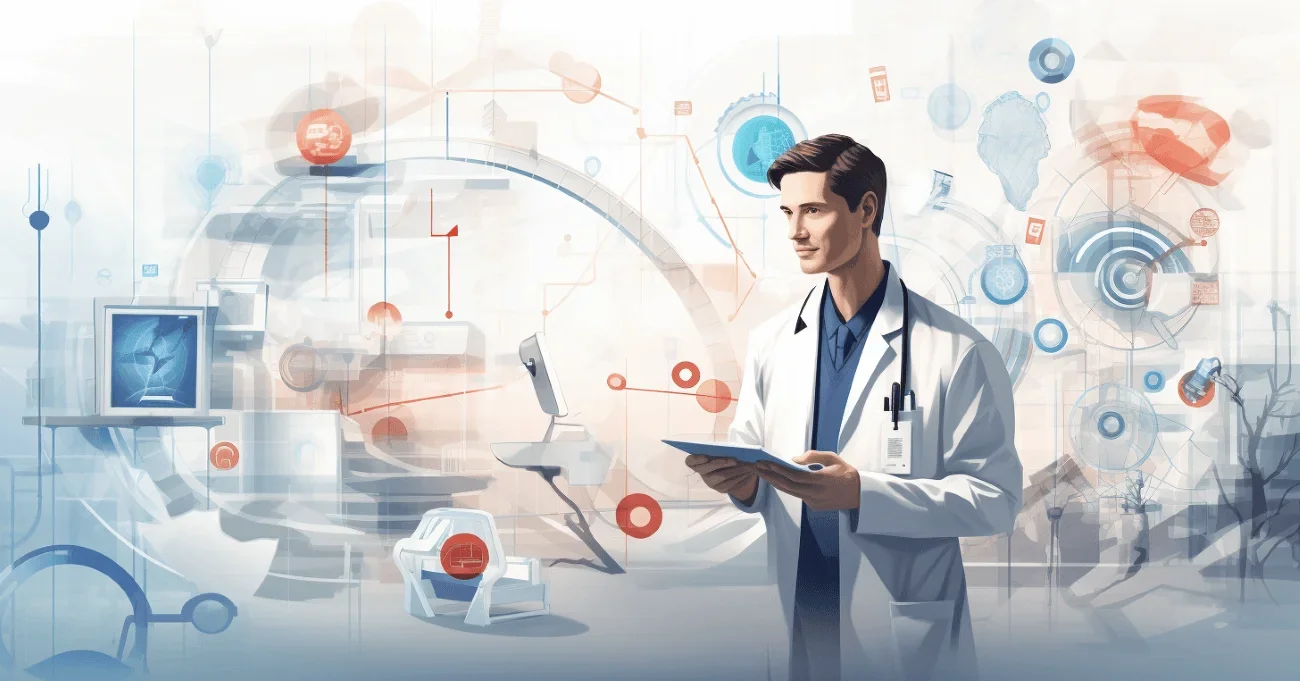A healthcare CRM enables professionals in the industry to streamline operations, improve patient engagement, and increase revenue. Since the healthcare industry continues to expand, it's essential to consider the key features and functions of an excellent healthcare CRM. With that, users can keep up with the increasing demand for personalized care and better patient experience.
Aloa and its partner network of outsourced software developers realize just how vital a healthcare CRM is for industry professionals and businesses. Our experience developing a CRM system for orthodontists, Pepcare, incorporated essential features that compile all doctor-customer interactions in one place.
In this blog, we'll apply the knowledge we've gathered from developing Pepcare and streamline it into a guide on building a CRM platform for healthcare. We'll go through the steps to take before, during, and after development, the essential features to include, and benefits associated with such a solution.
You'll have a comprehensive guide to starting your healthcare CRM development process by the end.
Let's get started!
How To Build an Outstanding Healthcare CRM?
Building a custom healthcare CRM requires thorough research and industry knowledge. Developers must consider industry best practices and policies to ensure they meet the standards set by healthcare regulatory bodies. After that, your developed system should support patient relationship management, healthcare marketing, and engagement through effective patient communication.
Let's look into the prerequisites necessary before you formally begin the development process:
Key Considerations Before Building a Healthcare CRM
Healthcare CRM (customer relationship management) software ensures patient satisfaction, efficient patient records management, and successful healthcare marketing initiatives. Before you can achieve all those goals, however, it's best to look into the following key considerations:
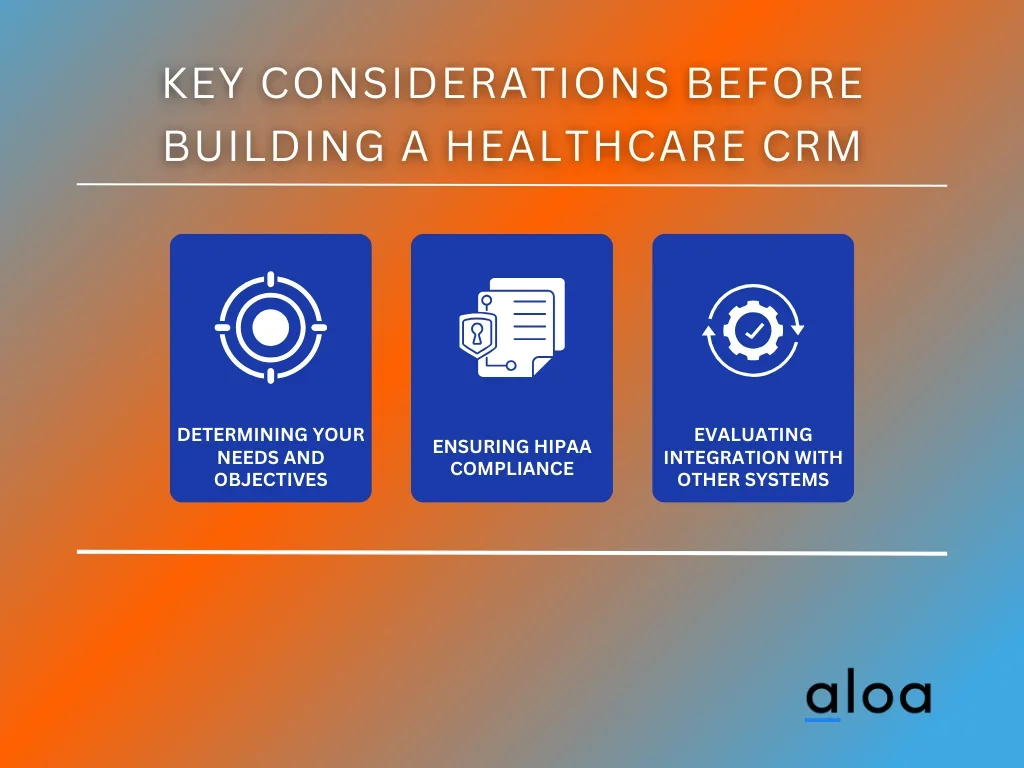
Determining Your Needs and Objectives
Define objectives for patient engagement, sales and marketing campaigns management, and data management. Evaluate solutions for patient satisfaction, marketing, and provider support. Taking the time to accomplish needs and objective strategies then ensures you develop the right tools to improve patient care and operational efficiency.
Ensuring HIPAA Compliance
HIPAA Compliance refers to adhering to the regulations set by the Health Insurance Portability and Accountability Act. Any healthcare CRM system must comply with HIPAA guidelines to ensure the privacy and security of patient data. This includes implementing measures such as:
- Audit trails
- Access controls
- Secure data encryption
- Regular vulnerability assessments
Keeping to HIPAA compliance, healthcare CRM solutions ensure secure patient engagement and information management when interacting with healthcare providers.
Evaluating Integration with Other Systems
As you explore developing healthcare CRM software, it's also crucial to consider how the final system will integrate with existing systems. In most cases, a CRM system works in tandem with other software solutions to create a seamless experience wherein all data is aggregated in one dashboard or location.
Healthcare integrations include electronic health records (EHR) systems, practice management software, telehealth platforms, and billing solutions. The ability to seamlessly integrate with these systems streamlines workflows and enhances efficiency in patient care.
After considering the points above, it'll become easier to dive into the main steps of building a healthcare CRM system that meets industry standards and requirements.
7 Steps to Build a Healthcare CRM
Building a custom healthcare CRM requires thorough research and industry knowledge. Developers must consider industry best practices and policies to ensure they meet the standards set by healthcare regulatory bodies. After that, your developed system should support patient relationship management, healthcare marketing, and engagement through effective patient communication.
Here's how to accomplish that as you start to build your CRM for healthcare:
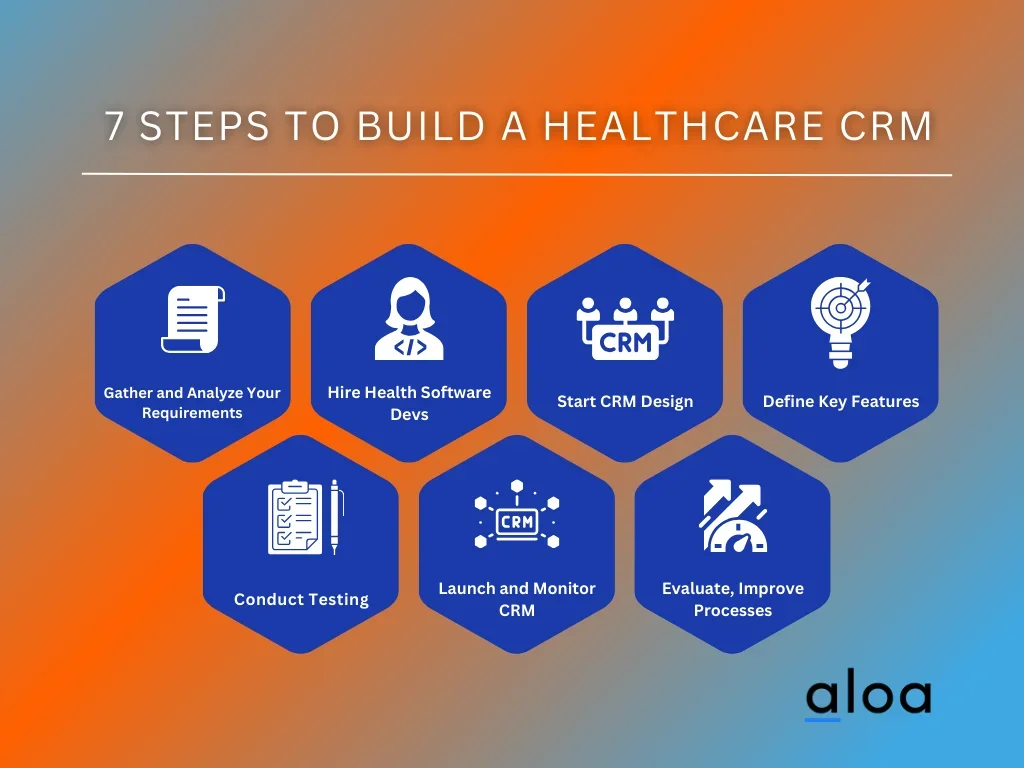
Step 1: Gather and Analyze Your Requirements
The first step towards building a successful healthcare CRM is to gather and analyze your requirements. These requirements include the critical considerations listed in the previous section. Apart from ensuring your developed system adheres to industry standards, gathering and analyzing your needs also ensures you proceed with development in an organized manner.
To further streamline the development process of a CRM for healthcare, you'll also need to understand who the final users of the system will be. Since the main purpose of a healthcare CRM is to improve patient care and enhance efficiency, it is crucial to identify the different stakeholders involved. This could include healthcare providers, administrators, patients, and even third-party entities such as insurance companies.
Here's how the different parties involved will use a CRM in healthcare for daily processes:
- Healthcare Providers: Healthcare providers are the primary users of a healthcare CRM. They rely on the system to manage patient data, track medical records, and schedule appointments.
- Administrators: Administrators play a crucial role in the efficient functioning of healthcare organizations. Administrators can save time and improve overall operations by centralizing these processes in a CRM.
- Patients: Patients are increasingly becoming active participants in their own healthcare journey. A healthcare CRM can empower patients by giving them access to their medical records, appointment scheduling, and communication with healthcare providers.
- Third-Party Entities: Insurance companies and other third-party entities also play a significant role in the healthcare ecosystem. A healthcare CRM can facilitate smooth interactions between these entities and healthcare providers by
Considering the main stakeholders of your CRM then goes towards making sure it is an effective system based on how they use it and how it meets their specific needs. Regardless of who the stakeholders are, always keep in mind industry compliance standards like HIPAA (Health Insurance Portability and Accountability Act) to ensure the security and privacy of patient information.
Step 2: Hire Professional Healthcare Software Developers
Once you've gathered and analyzed all the essential requirements, it's time to start sourcing and hiring professional healthcare software developers. Software developers specializing in healthcare technology are best suited to handle your CRM for healthcare projects since they will have the industry knowledge required to adhere to specifications set by the industry.
As you source and hire healthcare software developers, you must look into the following aspects of their portfolio:
- Experience in developing healthcare software solutions
- Knowledge of HIPAA compliance and other industry regulations
- Ability to integrate with existing healthcare systems and databases
- Expertise in developing CRM systems specifically for the healthcare industry
- Track record of successful projects and satisfied clients in the healthcare sector
The vetting process will entail taking a detailed look into each developer's qualifications, experience, and track record. Choosing developers with a strong understanding of the healthcare industry and its unique requirements is important. Look for those who have developed healthcare software solutions in the past, as they will be familiar with the challenges and complexities involved.
Step 3: Begin Designing Your CRM Structure
Creating the structure of a healthcare CRM depends on various factors, such as the specific needs of the healthcare organization, the type of services offered, and the desired outcomes.
Here are some key structural elements to consider when designing your healthcare CRM structure:
Key Modules
These could include patient management, appointment scheduling, medical records, billing, and invoicing. Overall, key modules are the essential features system users will need to accomplish their daily tasks and objectives when handling patient or doctor-side tasks.

User Roles and Permissions
User roles and permissions make it easier to organize the flow of data and ensure that only necessary stakeholders access vital information for customer support. Determining the various roles within a healthcare CRM system includes assigning who manages certain aspects of the system. Assigning the right roles to the right personnel also improves security and confidentiality when handling patient information.
Security Measures
Since healthcare systems contain confidential data, your CRM must include robust data security measures by implementing encryption protocols, user authentication mechanics, and regular data backups. Including regular security audits also ensures that you can identify and address any vulnerabilities in the system should they arise.
Training and Support Modules
To ensure smooth implementation and usage of your healthcare CRM, it is vital to include training and support modules in your CRM structure. These modules can provide comprehensive training materials, user guides, and tutorials to help healthcare staff quickly adapt to the new system. Additionally, a dedicated support team should be available to address any questions or issues that may arise during the transition period or ongoing usage.
CI/CD Capabilities
To keep up with the ever-evolving healthcare landscape, it is important for a healthcare CRM system to have continuous integration and continuous deployment (CI/CD) capabilities. This enables seamless updates and enhancements to be rolled out without disrupting the workflow of healthcare professionals.
With CI/CD capabilities, developers can make changes to the CRM system and deploy them in a controlled manner. This ensures that bugs or issues are identified and resolved quickly, minimizing potential impact on patient care.
Step 4: Determine Core Features and Capabilities
As you continue in the process of developing a healthcare CRM, determining the core features and capabilities of your solution is crucial. The main difference between the structure and features of a healthcare CRM is that the structure focuses on the overall efficiency and compliance of the system. In contrast, the features are designed to meet the specific needs of healthcare organizations.
Here are a few features to consider including in your CRM system:
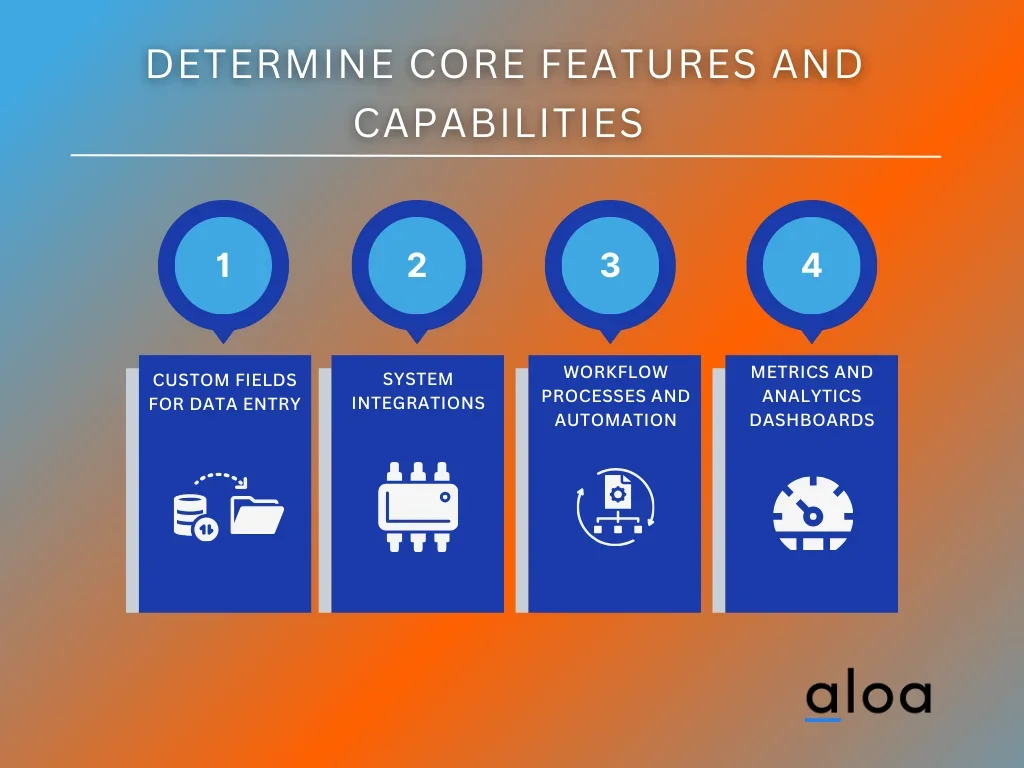
Custom Fields for Data Entry
Depending on who the main stakeholders or users are, outlining what sorts of fields you require for data entry captures relevant information about each element. Custom fields could include personal data, medical history, insurance information, and treatment plans.
System Integrations
System integration refers to how your CRM will work with other existing systems like electronic medical records (ERM), practice management software, or other healthcare systems. Having seamless integration capabilities streamlines and minimizes the need for manual data entry from one system to another. In return, users experience time-saving efforts and better overall data integrity with minimal mistakes.
Workflow Processes and Automation
Workflow processes and task management automation play a critical role in optimizing the efficiency of a healthcare CRM. By automating repetitive tasks and streamlining workflows, healthcare organizations can improve productivity and reduce the risk of errors.
Metrics and Analytics Dashboards
Metrics and analytics dashboards are essential components of a healthcare CRM system. These features enable organizations to track and analyze important data in real-time, providing valuable insights for decision-making and improving patient care.
With metrics and analytics dashboards, healthcare providers can monitor key performance indicators such as patient satisfaction, appointment wait times, and treatment outcomes. These visual representations of data help identify trends, identify areas for improvement, and make data-driven decisions to enhance operational efficiency.
Step 5: Perform Compliance and Usability Testing
Performing compliance and usability testing processes during the development of health systems is crucial for a healthcare CRM system. Compliance testing ensures the system meets all necessary regulatory requirements and standards, such as HIPAA compliance for safeguarding patient data. Usability testing, on the other hand, focuses on ensuring that the system is intuitive and user-friendly for healthcare professionals.
During compliance testing, developers assess the CRM's security measures, access controls, and data encryption protocols to ensure that patient information remains secure and protected. This process involves rigorous testing to identify any potential vulnerabilities or breaches in the system.
Usability testing evaluates how easily healthcare professionals can navigate and use the CRM system. Usability testing involves gathering feedback from end-users, such as doctors and nurses, to identify any pain points or areas for improvement in the system's user interface and functionality. This feedback is invaluable in refining and optimizing the healthcare CRM for a seamless user experience.
Step 6: Launch and Monitor the CRM's Performance
After conducting the essential compliance and usability testing, you'll have a formal minimum viable product (MVP) to launch to your users. As you launch your healthcare CRM, it's still necessary to monitor how it performs in a real-world setting.
Doing so means evaluating, tracking, and recording potential areas for improvement. Taking the time to compile and analyze data on user engagement, system performance, and overall customer satisfaction will allow you to make informed decisions about updates and enhancements to your healthcare CRM.
Moreover, it's essential to establish a streamlined communication process with your users and development team. Communication includes outlining clear instructions on how to access and utilize the CRM system and offering training sessions and resources that ensure those using the system become familiar with the platform.
To do so, you can include training modules into a healthcare learning management system that users can access as they explore the platform or include training features within the system.
From there, regularly monitoring the CRM's performance involves tracking key metrics such as user adoption rates, response times, and error rates. The data gathered will then give you insights into any potential bottlenecks or areas for improvement.
Step 7: Conduct Evaluation and Process Improvement
Once you have insights into the performance of your healthcare CRM, it's time to conduct a thorough evaluation and process improvement. This step is crucial as it allows you to identify gaps or inefficiencies in the system and make necessary adjustments.
Start by analyzing the data gathered during the monitoring phase. Look for patterns, trends, and outliers that can provide valuable insights into the CRM's performance.
- Are there any specific areas where users are facing challenges or experiencing frustration?
- Are there features or functionalities that are not being utilized effectively?
Based on these findings, prioritize the areas that require improvement. Develop a plan to address each issue and assign responsibilities to the appropriate team members. This could involve enhancing the user interface to make it more intuitive, streamlining processes to reduce response times, or providing additional training and resources for users.
Essential Features of a Healthcare CRM System
The essential features of a healthcare CRM system aim to improve and streamline processes and workflows for all stakeholders involved. With that, here are a few features that you should consider including in your system for optimal performance and user-friendly design:
Admin-side Features of a CRM System for Healthcare
On the admin side, a healthcare CRM system should have features that empower administrators to manage and optimize the system effectively. Some essential admin-side features include:
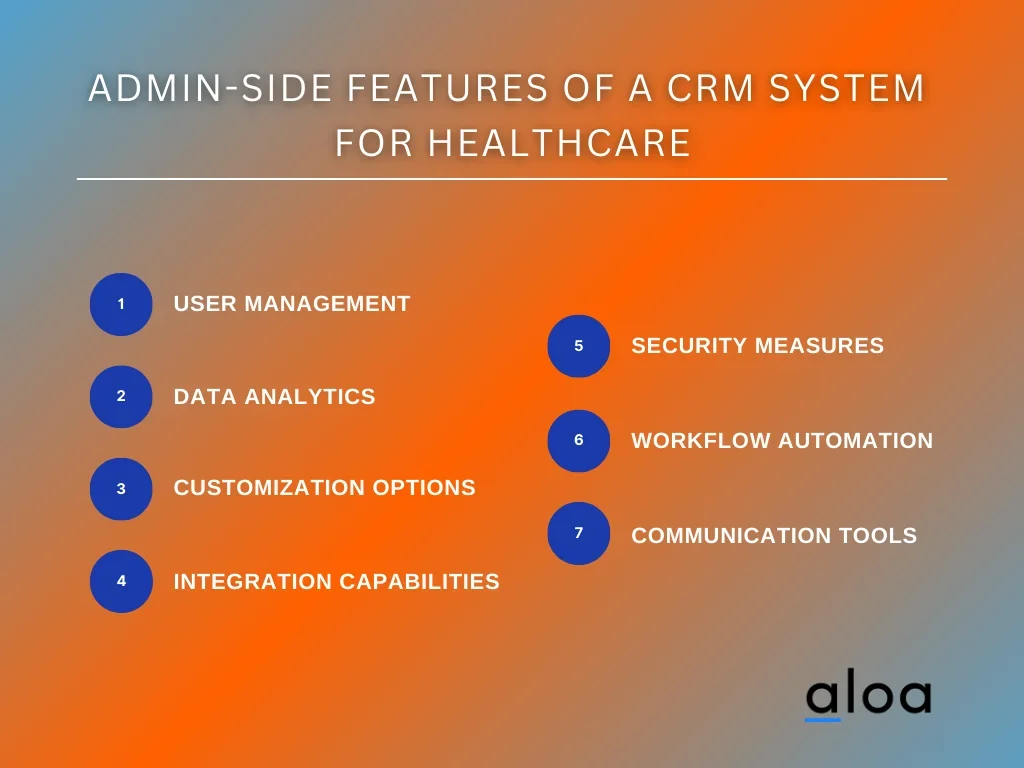
- User Management: The ability to easily create, modify, and delete user accounts, as well as assign specific roles and permissions to ensure data security and privacy.
- Data Analytics: Robust analytics tools give administrators insights into key metrics such as patient engagement, lead conversion rates, and overall system performance. This data can help identify areas for improvement and drive strategic decision-making.
- Customization Options: A flexible CRM system allows administrators to customize the system to meet their needs. This includes the ability to modify fields, forms, and workflows and create custom reports and dashboards.
- Integration Capabilities: Seamless integration with other systems and software used in healthcare organizations, such as electronic health records (EHR) and billing systems. This ensures smooth data flow and eliminates the need for manual data entry.
- Security Measures: Robust security features, including user authentication, encryption of sensitive data, audit trails, and regular backups. These measures are essential to protect patient information and comply with privacy regulations such as HIPAA (Health Insurance Portability and Accountability Act).
- Workflow Automation: Efficient automation of routine tasks and processes to save time and improve productivity. This can include automated appointment reminders, follow-up emails, task assignments, and streamlining administrative workflows.
- Communication Tools: Built-in communication tools such as messaging or chat functionalities allow administrators to communicate easily with staff members, healthcare providers, and other stakeholders within the system.
User-side Features of a CRM System for Healthcare
A user-friendly interface that is intuitive and easy to navigate allows administrators to quickly access the necessary information.

- Customizable Dashboards and Reports: Provides real-time insights and analytics on patient interactions, appointments, and overall performance of the healthcare organization.
- Mobile Accessibility: Enables administrators to access the CRM system from anywhere, anytime, using their smartphones or tablets.
- Collaborative Features: Allow multiple users to work together on tasks or projects within the CRM system, improving teamwork and coordination regarding patient outreach.
- Appointment Management Tools: Enables administrators to schedule, reschedule, and cancel appointments with ease, reducing scheduling conflicts and improving
- Training and Support: Comprehensive training materials and ongoing technical support ensure administrators can effectively utilize the CRM system's features and troubleshoot any issues that may arise.
- Billing and Payment Processing: The healthcare CRM system also encompasses efficient billing and payment processing capabilities. With this feature, administrators can easily generate and send accurate invoices to patients for services rendered.
Benefits of a Well-designed Healthcare CRM Solution
Improving patient experience through efficient healthcare service delivery is a vital benefit of a well-designed healthcare CRM. Operational efficiency increases significantly with healthcare CRM tools, leading to streamlined patient management and enhanced satisfaction. Furthermore, the system optimizes patient relationship management, fostering increased engagement and better care quality.
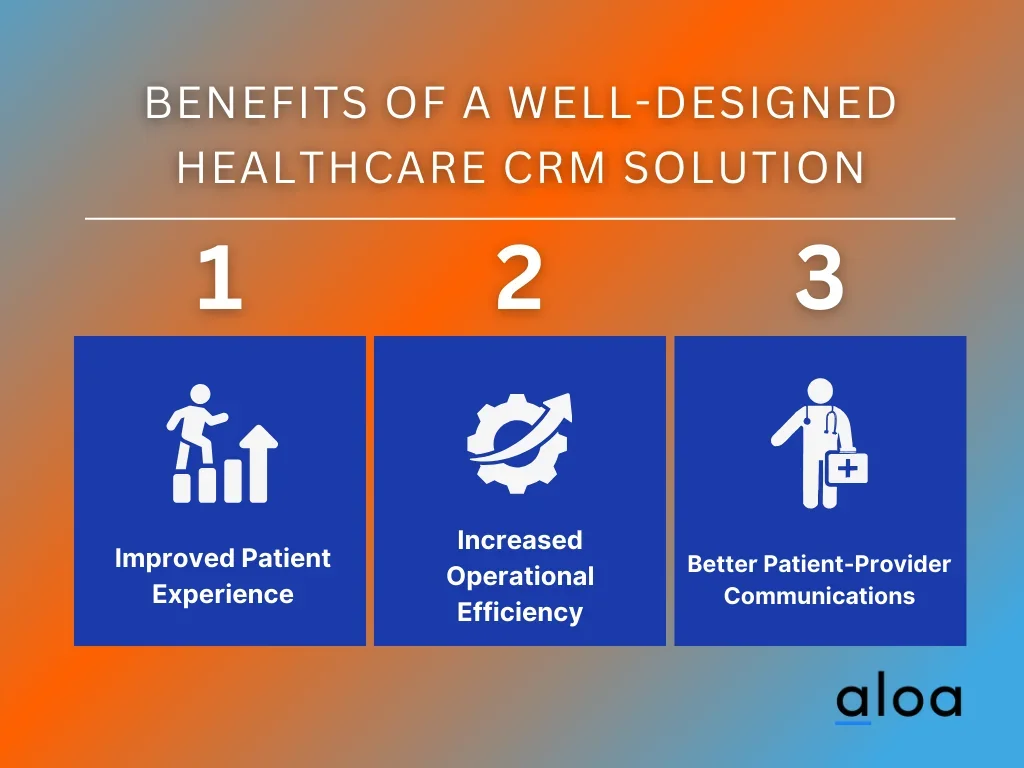
Improved Patient Experience
Personalizing patient experience with a healthcare CRM system ensures enhanced customer service and engagement. Efficient service delivery and streamlined patient management create a seamless healthcare experience. Optimized communication further enhances the overall patient experience, improving engagement and satisfaction. This approach benefits patients and contributes to the success of healthcare practices.
Increased Operational Efficiency
Utilizing healthcare CRM software streamlines healthcare operations, optimizing service delivery and achieving operational excellence. Efficient patient management improves service delivery, while streamlined patient data management enhances operational efficiency. NLP terms: health insurance, accountability act, new patients, medical CRM, social media, potential customers.
Better Patient-Provider Communications
Effective communication between patients and healthcare providers is crucial for delivering quality care and building strong patient-provider relationships. A well-designed healthcare CRM solution facilitates seamless and timely communication, improving patient-provider interactions.
With features like appointment reminders, automated follow-ups, and secure messaging systems, healthcare CRM tools enable efficient communication channels. This helps address patient queries and concerns promptly and fosters trust and engagement between patients and providers.
Key Takeaway
Building a healthcare CRM transforms the healthcare industry, whether a small business, private practice, or enterprise-level organization. With the right structure and features incorporated into the system, you can streamline operations and improve patient experiences for better outcomes. As you begin development, however, it is crucial to consider your needs and objectives and weigh that against user expectations.
Including all the necessary features, such as health insurance integration, compliance with the Accountability Act, and ease of onboarding new patients, will ensure your healthcare CRM meets industry standards.
Remember, the ultimate goal of a healthcare CRM is to enhance patient care and improve operational efficiency. With robust patient data management capabilities, you can easily access and analyze patient information to make data-driven decisions and provide more personalized care.
If you're ready to begin the development process for your healthcare CRM, reach out to our Account Executives at [email protected] for more information. Our team will walk you through an in-depth development process and plan that meets your specific requirements and works towards creating an innovative custom software solution.

